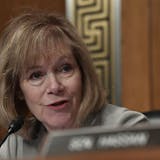Minnesota agencies, nonprofits, local governments and health care organizations were all scrambling Tuesday to understand the ramifications of a national federal assistance freeze before it was temporarily blocked by a federal judge.
By Wednesday afternoon, the Trump administration issued a one-page memo saying it was dropping plans for the funding pause for now.
The swirl sparked a panic that funding could be on hold for weeks while the federal government did a massive ideological review of how taxpayer dollars were being spent. Minnesota quickly joined a legal effort against the directive and Gov. Tim Walz said it jeopardized $1.8 billion the state receives each month in “funding for law enforcement, farmers, schools, veterans and health care.”
“Most folks were up all night last night as we dealt with this being thrown on there with no guidance. I know you have a lot of questions. I have a lot of questions because not one damn person thought this through,” Walz said Tuesday from the St. Paul Eastside YMCA.
“My words on this are going to be simple to the Trump administration: We’ll see you in court.”
While the effort is paused for now, here’s what we know about how the administration’s memo could affect state services:
What kind of funding could be paused?
The memo cites the more than $3 trillion spent in 2024 on federal financial assistance, such as grants and loans. Grants that have been awarded but not sent yet could also be frozen. Nonprofits, higher education institutions, state and local governments and health care organizations all receive federal funding.
Is anything exempt from the freeze?
There are some major programs that would be excluded from the pause in assistance. Medicare and Social Security benefits will be unaffected by the freeze, as well as any federal assistance “received directly by individuals,” such as student loans and scholarships.


